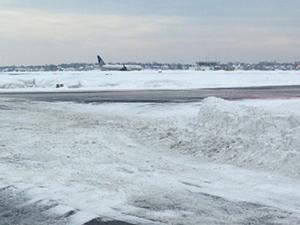Tue, Oct 04, 2016
Launches Website With Information About Takeoff And Landing Performance Assessments
As winter approaches, U.S. airports, airline flight crews, dispatchers, general aviation pilots, air traffic controllers, and manufacturers will begin using new Takeoff and Landing Performance Assessment (TALPA) methods to improve safety at U.S. airports.

The FAA has launched a TALPA website with key information the aviation community needs to know to prepare for the TALPA changes, which will be effective tomorrow, October 1. FAA guidance, notices, alerts, videos, and frequently asked questions will help the aviation community reduce the risk of runway overrun accidents and incidents due to runway contamination caused by weather and other factors.
The FAA developed the standards based on the work of the TALPA Aviation Rulemaking Committee (ARC). As a result of the committee’s work, the FAA has developed a revised method for airports and air traffic controllers to communicate actual runway conditions to the pilots in terms that directly relate to the way a particular aircraft is expected to perform. The TALPA initiative improves the way the aviation community assesses runway conditions, based on contaminant type and depth, which provides an aircraft operator with effective information to anticipate airplane braking performance.
Airport operators will use the new Runway Condition Assessment Matrix (RCAM) to assess runway conditions, and pilots will use it to interpret reported runway conditions. The RCAM is presented in a standardized format, based on airplane performance data supplied by airplane manufacturers, for each of the stated contaminant types and depths. The RCAM replaces subjective judgments of runway conditions with objective assessments tied directly to contaminant type and depth categories.
The pilot or dispatcher will then consult the aircraft manufacturer data to determine what type of stopping performance to expect from the specific airplane they are operating.
The airport operator will assess surfaces, report contaminants that are present, and input the information into the Federal NOTAM System in order to generate the numerical Runway Condition Codes (RwyCC) based on the RCAM. The RwyCCs may vary for each third of the runway if different contaminants are present. However, the same RwyCC may be applied when a uniform coverage of contaminants exists. RwyCCs will replace Mu values, which will no longer be published in the Federal NOTAM System.
Pilot braking action reports will continue to be used to assess braking performance. Beginning October 1, the terminology “Fair” will be replaced by “Medium.” It will no longer be acceptable for an airport to report a NIL (none) braking action condition. NIL conditions on any surface require the closure of that surface. These surfaces will not be opened until the airport operator is satisfied that the NIL braking condition no longer exists.
(Image provided with FAA news release)
More News
Known Traffic With respect to ATC clearances, means aircraft whose altitude, position, and intentions are known to ATC.>[...]
Aero Linx: Aviation Suppliers Association (ASA) Established February 25, 1993, the Aviation Suppliers Association (ASA), based in Washington, D.C., is a not-for-profit association,>[...]
Abeam An aircraft is “abeam” a fix, point, or object when that fix, point, or object is approximately 90 degrees to the right or left of the aircraft track. Abeam indic>[...]
Aero Linx: The Air Charter Safety Alliance The group, called the Air Charter Safety Alliance, will raise awareness of illegal charter flights among potential customers, charter bro>[...]
“For months, ALPA has been sounding the alarm on the ongoing efforts by some aircraft manufacturers to remove pilots from the flight deck and replace them with automation. To>[...]
 ANN's Daily Aero-Term (06.10.24): Known Traffic
ANN's Daily Aero-Term (06.10.24): Known Traffic ANN's Daily Aero-Linx (06.10.24)
ANN's Daily Aero-Linx (06.10.24) ANN's Daily Aero-Term (06.11.24): Abeam
ANN's Daily Aero-Term (06.11.24): Abeam ANN's Daily Aero-Linx (06.11.24)
ANN's Daily Aero-Linx (06.11.24) Aero-News: Quote of the Day (06.11.24)
Aero-News: Quote of the Day (06.11.24)



